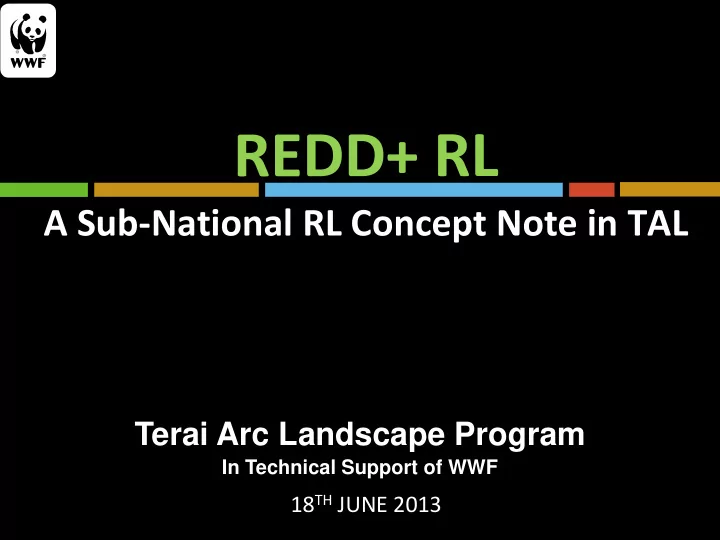

A Sub-National RL Concept Note in TAL Terai Arc Landscape Program In Technical Support of WWF 18 TH JUNE 2013
WHAT IS RL/REL Forest Reference Emission Levels &/or Forest Reference levels: Benchmarks for assessing a country’s performance in implementing REDD+ activities Expressed in tons of CO2 eq/ year Credible ones will be driven by historical data: any projections (while allowed) will receive substantial more scrutiny and criticism Benchmarks: Moving from REDD+ readiness – Demonstration- Performance Based Payments .
WHAT REALLY IS RL The most important thing about a REDD+ RL: Basis for determining whether a REDD program or policy is working. On REDD+, funding that is performance-based: RLs are essential to know the starting point of forest cover change and emissions in an area. RLs are a combination of empirical data, assumptions, and modeling. RLs are being discussed at project levels, subnational levels, nationally, internationally (UNFCCC), multilaterally (e.g., World Bank).
BASIS OF REDD+ RL The basic math is: Activity Data (ha loss or ha degraded/per year) X Emissions Factors (tCO 2 e/ha) = tCO 2 e/year Activity data will be based on satellite information (past) or assumptions (future) Emission factors will be based on field measurements & Allometric equations – they will be net changes in forest carbon between the classes used in the activity data
CONCEPT NOTE
PROPOSAL Approach: Historical RL @ a sub-national scale Base Year 1999 Project Area; 12 jurisdictional boundaries Tools: Img Tools (NDFI) and LiDAR (Arbo-LiDAR and LAMP) Generate activity data (AGC) (1999 to 2011) and emissions factors (derived from plot data and NDFI) Larger plots for calibration of LiDAR Allometric Equations Chave et all, Moist Forest- Diameter Model- (Equation: 1.3) Sharma and Pukkala
PROPOSAL: POOLS Above Ground Biomass Branches Below Ground Wood products Biomass Shrubs Litter Herbaceous vegetation Soil Organic Carbon Litter Soil Carbon Dead wood Roots
LIDAR • LAMP computes model-based estimates that take advantage of field plots, LiDAR, and satellite images like Landsat or RapidEye; • It produces an Above-ground biomass (AGB) map at high spatial resolution, from 1 ha upwards; • The AGB estimates are unbiased; • The estimates also preserve AGB variance present in LiDAR blocks; • The LAMP process does not depend on subjective expert opinion.
APPLYING IMG TOOLS FOR NDFI
NDFI: NORMALIZED DIFFERENTIAL FRACTION INDEX • Equations that combines Landsat’s wavelength returns into a single value to explain forests • A significant relationship between NDFI values and field derived estimates of carbon • We binned NDFI into forests with low, medium and high carbon values • These bins are the key pivot points for generating AGC values
VALUES Low: Bin I (1-90 NDFI) Mean C: 25tC/Ha Medium : Bin II (91-147 NDFI) Mean C: 59tC/Ha High: Bin III (148-199 NDFI) Mean C: 145tC/Ha
APPLYING NDFI and FOREST CHANGE The forest change information Deforestation (Bin II Bin I, or Bin III Bin I) Degradation (Bin III Bin II, Bin II-) Regrowth (Bin I Bin II, or Bin I Bin III) Enhancement (Bin II to Bin III) Can be applied to : a. Available forest classification Sal, Mixed hardwood, Riverine etc. by overlapping available forest classification over the FCD Mapper b. Physiographic classification, such as Terai and Siwaliks
ANALYSIS: BOOKEND APPROACH: 1999-2011: (2.9 MT OF CO2 EQ/YR)
ANALYSIS: TIME SERIES APPROACH: (2.64 MT OF CO2 EQ/YR)
ACCURACY ASSESSMENT
AGC 1999
AGC 2011
CHANGE DECTECTION 1999-2011
CHANGE DETECTION 1999- 2011
CENTRAL TERAI IN 12 YEARS: RAUTAHAT & BARA
WESTERN TERAI IN 12 YEARS: BARDIYA
WESTERN TERAI IN 12 YEARS: KAILALI
WESTERN TERAI IN 12 YEARS: KANCHANPUR
FINANCING Current Emissions: 2.64 Mt of CO2/yr Performance: Reduce by 50% Rate: $7/Mt of CO2 eq Revenue: 46.2 million in 5 years
LIDAR AND AGC • LiDAR model was correlated with recently measured 48 field plots with 30m radius LiDAR model has an R 2 value • of 0.92 and does not saturate at all. R 2 = 0.92
AGC- LIDAR AND NDFI • NDFI was correlated with AGB estimated using the LiDAR model developed for TAL NDFI has an R 2 value of • 0.44 but saturates at 300 tons/ha R 2 = 0.44
LAMP RESULTS AT 1Ha RESOLUTION R 2 = 0.53
LEARNINGS IN THE PROCESS • NDFI has strong correlation with forest cover change, • LiDAR has strong capapcity to pick up AGC, • Incorporation of NDFI in LAMP will enhance the capacity of LAMP to detect change and estimate AGC. • Choice for Allometry Equations
Work in progress (LAMP) : Carbon difefrence map at 1 ha resolution between 1999 and 2011
FCPF • FCPF is still in the process of designing the framework • Many countries getting ready to line-up for Carbon Fund, but not many that will be viewed as being READY. • It is important for Nepal to not delay in getting an initial ER-PIN before the fund. Ideally, October meeting, which would require a late September submission to the FMT
UNFCCC/SB-38 DRAFT CONCLUSIONS: Adopted NFMS: National Forest Monitoring Systems MRV- ICA: Monitoring Reporting and Verifications- International Consultations and Analysis RL: Reference Levels: 21 WEEKS REVIEW NMBA: Non- Market Based Approaches NCB: Non Carbon Benefits SAFEGUARDS: DRIVERS: REDD FINANCE:
COMMENTS!
Recommend
More recommend